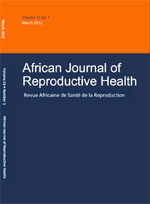
|
African Journal of Reproductive Health
Women's Health and Action Research Centre
ISSN: 1118-4841
Vol. 6, No. 1, 2002, pp. 107-108
|
 Bioline Code: rh02014
Bioline Code: rh02014
Full paper language: English
Document type: Research Article
Document available free of charge
|
|
|
African Journal of Reproductive Health, Vol. 6, No. 1, 2002, pp. 107-108
| en |
Effects of Different Temperatures for Drying Cervical Mucus Smear on their Crystallisation Pattern: A Short Report
SO Onemu
Abstract
The effects of different room temperatures for drying cervical mucus on crystallisation of fern-tree patterns was determined using cervical mucus smears from 60 women undergoing investigation for infertility at the University of Benin Teaching Hospital. Cervical mucus smears were dried in the oven at 15, 20, 25, 30 and 35°C and examined rapidly for fern-tree pattern crystallisation. Fern-tree patterns were formed consistently between 15 and 25°C. At 30 and 35°C fern-tree crystallisation patterns decreased significantly in proportion (p < 0.05); they became atypical or were not formed at all. The finding in this study demonstrates that in tropical environments where ambient room temperature may reach 35°C, fern-tree pattern would differ from those in temperate regions. (Afr J Reprod Health 2002; 6[1]: 107-108)
Keywords
Infertility, ovulation, cervical smears, fern-tree patterns, temperature
|
| |
| fr |
Les Effets des Diverses Températures Ordinaires pour le Séchage du Frottis des Mucosités Cervicales sur l'Aspect de Cristallisation: Un Compte rendu
SO Onemu
Résumé
Nous avons déterminé les effets des diverses températures ordinaires pour le séchage du frottis des mucosités cervicales sur l'aspect de cristallisation en fougère, à l'aide des frottis des mucosités cervicales, chez 60 femmes qui faisaient l'objet de l'enquête pour la stérilité au Centre Hospitalier Universitaire à Benin City. Les frottis des muscosités cervicales ont été séchés au four à une température de 15°C, 20°C, 25°C, 30°C et 35°C et ont été examinés très rapidement pour la cristallisation en feuille de fougère. Il y a eu des aspects en fougère qui ont été formés constamment entre 15°C et 35°C. A 30°C et 35°C, il y a eu une baisse remarquable des aspects de cristallisation en feuille de fougère en proportion (p < 0,05); ils sont devenus atypique ou bien non formés du tout. Le résultat de cette étude montre que dans les régions tropicales où la température ordinaire ambiante peut atteindre 35°C, l'aspect de fougère serait différent de ceux qu'on trouve dans les régions tempérées. (Rev Afr Santé Reprod 2002; 6[1]: 107-108)
|
| |
© Copyright 2002 - Women's Health and Action Research Centre
Alternative site location: http://www.ajrh.info
|
|
